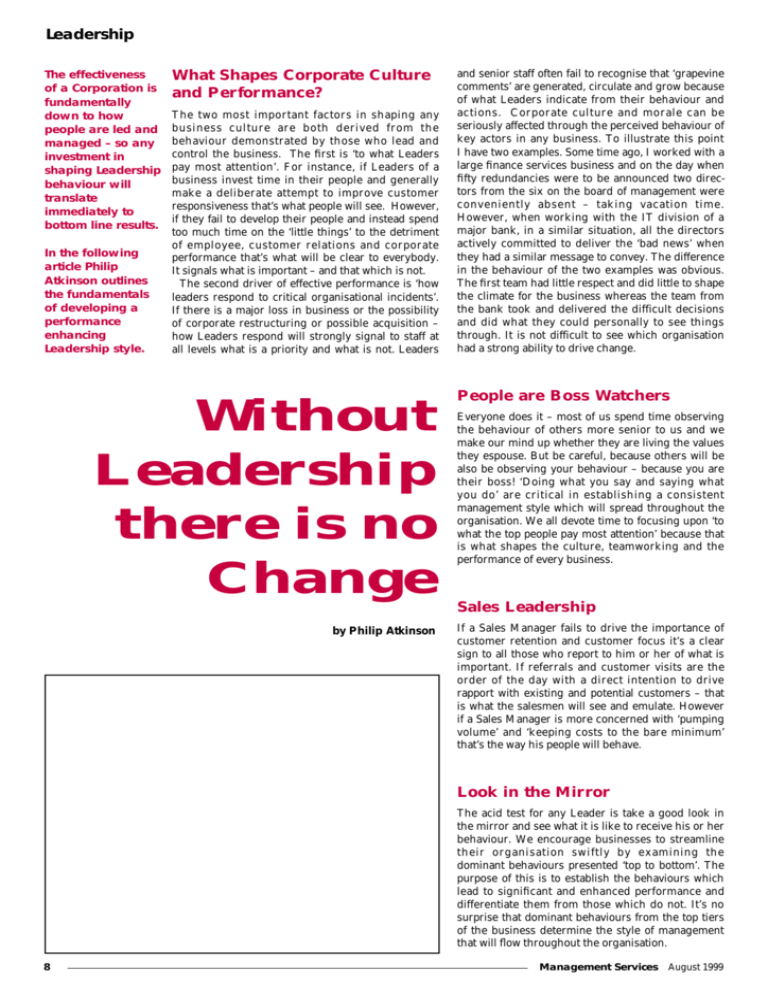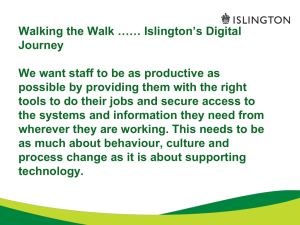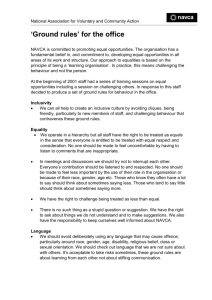Without Leadership there is no Change
advertisement

Leadership The effectiveness of a Corporation is fundamentally down to how people are led and managed – so any investment in shaping Leadership behaviour will translate immediately to bottom line results. In the following article Philip Atkinson outlines the fundamentals of developing a performance enhancing Leadership style. What Shapes Corporate Culture and Performance? The two most important factors in shaping any business culture are both derived from the behaviour demonstrated by those who lead and control the business. The first is ‘to what Leaders pay most attention’. For instance, if Leaders of a business invest time in their people and generally make a deliberate attempt to improve customer responsiveness that’s what people will see. However, if they fail to develop their people and instead spend too much time on the ‘little things’ to the detriment of employee, customer relations and corporate performance that’s what will be clear to everybody. It signals what is important – and that which is not. The second driver of effective performance is ‘how leaders respond to critical organisational incidents’. If there is a major loss in business or the possibility of corporate restructuring or possible acquisition – how Leaders respond will strongly signal to staff at all levels what is a priority and what is not. Leaders Without Leadership there is no Change by Philip Atkinson and senior staff often fail to recognise that ‘grapevine comments’ are generated, circulate and grow because of what Leaders indicate from their behaviour and actions. Corporate culture and morale can be seriously affected through the perceived behaviour of key actors in any business. To illustrate this point I have two examples. Some time ago, I worked with a large finance services business and on the day when fifty redundancies were to be announced two directors from the six on the board of management were conveniently absent – taking vacation time. However, when working with the IT division of a major bank, in a similar situation, all the directors actively committed to deliver the ‘bad news’ when they had a similar message to convey. The difference in the behaviour of the two examples was obvious. The first team had little respect and did little to shape the climate for the business whereas the team from the bank took and delivered the difficult decisions and did what they could personally to see things through. It is not difficult to see which organisation had a strong ability to drive change. People are Boss Watchers Everyone does it – most of us spend time observing the behaviour of others more senior to us and we make our mind up whether they are living the values they espouse. But be careful, because others will be also be observing your behaviour – because you are their boss! ‘Doing what you say and saying what you do’ are critical in establishing a consistent management style which will spread throughout the organisation. We all devote time to focusing upon ‘to what the top people pay most attention’ because that is what shapes the culture, teamworking and the performance of every business. Sales Leadership If a Sales Manager fails to drive the importance of customer retention and customer focus it’s a clear sign to all those who report to him or her of what is important. If referrals and customer visits are the order of the day with a direct intention to drive rapport with existing and potential customers – that is what the salesmen will see and emulate. However if a Sales Manager is more concerned with ‘pumping volume’ and ‘keeping costs to the bare minimum’ that’s the way his people will behave. Look in the Mirror The acid test for any Leader is take a good look in the mirror and see what it is like to receive his or her behaviour. We encourage businesses to streamline their organisation swiftly by examining the dominant behaviours presented ‘top to bottom’. The purpose of this is to establish the behaviours which lead to significant and enhanced performance and differentiate them from those which do not. It’s no surprise that dominant behaviours from the top tiers of the business determine the style of management that will flow throughout the organisation. 8 Management Services August 1999 Leadership Leadership behaviour is what is received – not that which is sent Most behaviour is ‘unconscious’. Although people are conscious of what they are doing, they may not be conscious of their motives and the impact this has on others. They may not be conscious of how their behaviour is received unless they have a high degree of sensitivity or spend time asking others and seeking feedback on their style. For this reason we regularly design specific 360 degree Leadership assessments looking not only at Leadership behaviour from a solitary managerial standpoint through self assessment – but also by winning the support of others. We ask co-workers, peers and colleagues for feedback as well as direct reports and others involved in any direct or indirect supply chain relationship. In a sales context we often seek feedback from customers or business partners so that managers can take a ‘reality check’ on their personal performance. This activity helps and is an excellent time to assess the potential of managers and Leaders and is a powerful way to structure a succession process within an organisation. Huge returns can be experienced when tailoring training and all development activities towards adding value to all team workers. Often this exercise will generate a whole list of questions – here are the top four. 1 Who is a Leader? Anyone who manages anybody is a Leader. Anybody who has responsibility for the performance of others is a Leader. If you have staff reporting to you your results are determined by how well you lead your people. A manager can leave today and a new recruit takes over the business tomorrow. The style of Leadership will significantly shift how she or he leverages people to deliver the results. Readers may know of many examples when a poor leader took over from a strong leader or where the situation was reversed. Leadership has a major impact on the performance of teams. Also consider the solitary individual with a more technical specialism – is there a role of leadership for this person? Of course – he or she is part of a supply chain and needs to demonstrate strong team behaviour to ensure that the supply chain is strong, firm and delivers to expectations. This person will influence how others operate. 2 Is there a difference between a manager and a Leader? Yes – a major and fundamental difference. We consider managers to be more transactional in nature – that is dealing with processes and protocols focusing upon the administration of the system to the detriment of the future of the business. Managers may do the job right – but Leaders will do the right job. Leadership is about transformation and is largely to do with challenging the way business is achieved. This requires an enthusiastic manner and view for creating a strong vision for the organisation and ensuring that they inspire others to achieve this performance. Transformational Leaders will devote August 1999 Management Services time to ‘thinking out of the box’ taking thoughtful risks and building strong teams of people to work across boundaries and silos. 3 Can you have too much Leadership? We have yet to find an organisation which does – although there are plenty of businesses which are making great strides in how they drive for change. The real focus should be on ‘what can we do better, quicker, in a more customer focused manner?’ Philip Atkinson BSc MSc Leadership can soon be created and the effect of a is a Director of strong Leadership programme will be instant. Just Transformation UK Ltd. think now – in your organisation, what percentage of He is a specialist in those who manage others are Leaders? Now consider Organisational if it was possible to increase that by a factor of 10 -15% Transformation and – to create those with the attributes to drive cultural change, sustained change and improvement – what effect author of five books would that have on your business performance? and over 100 articles. He works closely with 4 What benefits can you expect many organisations in from a strong Leadership the UK, Europe and programme? the US. Philip can be contacted on ❐ Behaviours will be clarified which will immediTel 0131-346-1276 ately lead to improved team performance. or email: ❐ Leadership will exist by design rather than by phil@transform.win-uk.net default and will quickly highlight desired ways of working and team building from those strictly task led behaviours to become more creative and strategic. ❐ Development activities can be designed specifically to support managers as they manage the transition to the strong transformational model of behaviour. ❐ Clear signals will be given to new recruits or those new to a managerial career. ❐ ❐ ❐ ❐ ❐ “The Leader is not Morale within teams will increase because team employed to be a members will be expecting and experience a super independent freedom to succeed – simply because trust will and sole performer take over from control. but, rather, Performance management will be taken committed to seriously and cultural measures can soon achieve results become tangible. through others – so Most importantly, those who are ‘early adaptors’ that ultimately will be able to support those who take a little Leadership is more time to practice the skills. about creating an empowered The focus of the organisation will be on culture which is ‘achieving the best from their teams.’ self sustaining.” It is pretty obvious that the real benefit accrues to business who require to attract the top talent “Leadership is the in their field. Today, many new recruits of the significant factor in right calibre are a scarce resource and genuinely impacting upon will commit only to a business if they feel that organisation there is ‘psychological contract’ where they will performance and have the guidance and training to excel – not just one which many in their specialism but in the wider world of business leadership. Those companies that fail to organisations need to address as we develop sound HR strategies to attract and build work through the and retain strong leaders will not have the best early years of the choice of the market and therefore their results new Century.” will reflect the quality of the talent they recruit. 9 Leadership If they create a strong strategy to develop all their people – and get their people in a supportive environment to challenge some of their mostly secret ‘self limiting beliefs’ they will be contributing to improving not just work performance but also real personal development. Characteristics of Ef fective Leaders? We all know that effective leaders pursue transformational type behaviours but what specifically do they need to do more and less of in terms of driving change through team work? We call these the top 5 E’s. Energise Energy Those who can energise self and work independently of others will only be partially successful. How can we expect others to have a passion for a subject if the leader is less than luke-warm to the issue. Energising others demonstrates a strong way of behaving which acts as a role model or a template which others can emulate. The Leader who understands how important it is to get his team to express themselves confidently and with pride will probably commit to help them improve their influencing and presentation skills. When first faced with the ‘presentation challenge’ many people are less than enthusiastic – but if energised and supported they will benefit enormously from any opportunity to present in public. This is exactly the experience which will boost their self confidence. Leaders must be able to energise themselves. They must display a high degree of energy to demonstrate their resilience and their ability and stamina to contribute in a demanding business. Energy means being positive. It is unlikely that someone who displays inactivity and a lacklustre desire to improve things will be able to work closely with challenging projects. Energy is what keeps people out of bed at night and at the same time gets them up early in the morning – it is no surprise that successful people generally tend to be ‘early risers’ and achieve more with less. Enthusiasm Self-confidence is a strong key to effective Leadership. If a leader fails to display self confidence and has a less than positive self esteem it is unlikely that they can inspire others to superlative performance. The major factor holding people back from achieving their potential is their personal beliefs about what they can and cannot do. The oft quoted statement from Henry Ford is 100% correct – ‘Whether you can or you can’t you’re right’. People with low self-esteem will not wish to move as readily out of their comfort zone as those who generally believe ‘life is going to turn out okay’. This is a golden opportunity for the organisation to really commit to the development of the potential of their people. Execute Managers who prevaricate and weigh up all options in minute detail before they are prepared to make a decision will never become Leaders. Leaders have to be decisive after taking in relevant data, comparing the ‘pro and anti cases’ and then deciding and execution of the decision is the norm. People who fail to take decisions fail to learn from their experiences. If people examine their own lives they will find times when they made good decisions from those which they made poor choices. We suspect that more East Midlands Region East Midlands Region Event 28 October 1999 Productivity Forum D10 Building, Boots Contract Manufacturing, Nottingham 3.45 Arrival 4.00 Factory Tour of D10 5.30 Productivity Improvement – – National IMS Survey Profit Improvement Programmes 6.00 Supply Chain Management 6.30 Quality Impacts on Customer Service 7.15 Open Forum with Questions For further information please contact: John Lucey – 0115 959 3196 Geoff Mansfield – 0115 968 6972 10 SPONSORSHIP FOR WORLD XITH PRODUCTIVITY CONGRESS The East Midlands Region Board have decided to sponsor one delegate to attend the IMS World XIth Productivity Congress in Edinburgh in October. The Region will cover the attendance fee with accommodation costs being met by the delegate. ❐ ❐ ❐ ❐ ❐ Anyone interested should send a one page request detailing: Name Employer Position IMS Grade Reasons why you should be chosen by 10th August 1999 To: Geoff Mansfield, Business Process Improvement Manager, Boots Contract Manufacturing, D10 Building, Nottingham NG90 2PR Management Services August 1999 Leadership learning came when decisions did not go as expected. People who fail to make decisions – until they have every last piece of the jigsaw puzzle – will never make anything happen because they do not move away from their comfort zone. Leaders who are decisive have to be equally good at ensuring that others understand what is expected of them and the methods for implementing and sustaining changes from the decisions made. Here a leader who is 100% committed to rigorous decision making will know precisely how much support he or she will have to give their people to help move them the next rung up their own personal performance ladder. Edge The top ten percent of people in any profession or business will never be in need to look for a job – they will always be in demand and will be valued by their employers. Living on the edge is to be seen as being knowledgeable and greedy for new ways of looking at things and current problems. Always alert and always open to new ways of working is what characterises the sharp people who live on the edge. ‘Edge people’ are challenging the way things are done to improve performance. It does not mean that they are workaholics – but they are wise in how they use time to best effect. We personally believe that no one should need to spend more than 8-9 hours at work everyday to achieve their objectives. If they need more time they are probably doing some else’s job or not being sufficiently skilful or disciplined to differentiate the high priority – high payoff activities from non-value added work. There are many other behaviours which are pivotal to Leadership performance but our experience is ‘develop the person inside out’ – so that benefits accrue to the organisation and the individual. Summary Leadership is a critical issue for many businesses as we move into the early years of the new century. Talent is a scarce resource and good quality people are not in abundance. Competition will intensify for the best people. Organisations and their top teams need to recognise that they face a ‘Leadership challenge.’ Those Businesses that can implement strategies for continued and sustained improvement will be those peopled by high flyers. High flyers don’t just happen by accident – they have to be created – so the phrase ‘Leaders are born not made’ does not carry any credibility anymore. Organisations with the right focus and passion for developing their people will realise their vision for their business. Personal style is important. If a team Leader cannot instill others with the energy and enthusiasm to drive improvements then it may be time for that team Leader to let someone else take charge. If Leaders are not part of the solution then they are probably part of the problem and a Leader who fails to commit to personal improvement should move over and let others take charge. The benefits of developing a strong Leadership style which is fundamentally more transformational makes so much sense it is surprising that many companies still fail to commit to investing in their most senior people – those who lead others. What is required is a strong blend of transactional and transformational style with an equal respect for each other’s talents – but what is critical is a real thirst to drive for continuous improvement. Finally an interesting point is that once your business has established a strong Leadership style the business will be able to sustain any drive for change you wish to consider and guarantee a competitive edge second to none. ■ IMS Personal Career Portfolio The Institute’s Personal Career Portfolio has been published in response to the many requests from members of the Institute. of Institute ent m e g Mana Services The overall continuing professional development system consists of five stages, all linking together, enabling a CPD plan to be developed, actioned and monitored over a twelve month cycle. l Career Persona o Portfoli The personal career portfolio folder contains the full CPD scheme together with master copies of the forms for the record keeping process which can be photocopied for use. g ontinuin IMS – C nt velopme e D l a n o Professi ‘Personal Career Portfolio – the IMS continuing professional development scheme’ is available from Membership Services Department (please mark your request PCP) Price: £10 to Students and Associates, £20 to Members and Fellows. (Prices for overseas despatch on application). Tel: 0181 366 1261 August 1999 Management Services Fax: 0181 367 8149 E-mail: msdept@imgtserv.co.uk 11







